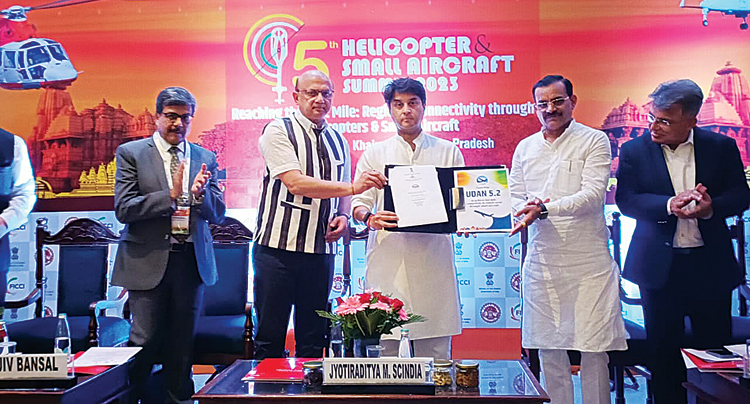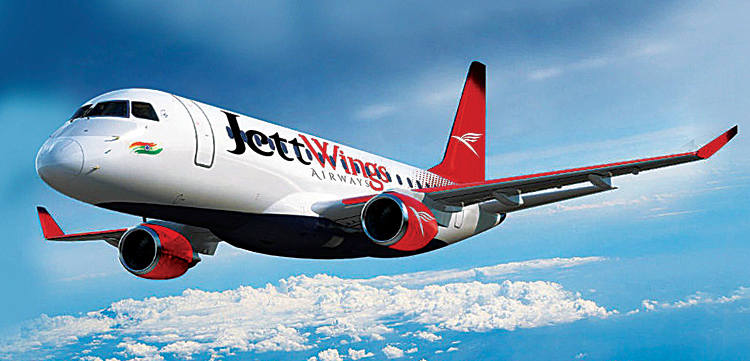Developing Regional Connectivity in India
Connecting remote India, one route at a time

The development of regional connectivity in India has been a significant focus of the government’s efforts to boost economic growth, tourism, and overall accessibility to remote and underserved regions of the country. The Regional Connectivity Scheme (RCS) – Ude Desh Ka Aam Nagrik (UDAN), launched in 2017, has played a pivotal role in revolutionising regional air travel and bringing aviation to the masses.
Since its inception, UDAN has witnessed remarkable progress, connecting numerous unserved and underserved airports across the country. Recent developments under the UDAN scheme have further strengthened regional connectivity in India. The government has continually added more routes and airports to the scheme, expanding air connectivity to even the remotest corners of the country. As a result, more people now have access to convenient and efficient air travel options, saving time and enhancing overall connectivity. It has contributed significantly to the growth of smaller regional airports, allowing them to play a crucial role in boosting local economies and tourism.
Additionally, the UDAN scheme has promoted the growth of regional hubs, facilitating seamless travel and transit between smaller cities and major aviation hubs. This has boosted regional economies, attracted investments, and enhanced tourism prospects for these areas. Furthermore, the recent advancements in technology and infrastructure have made regional air travel more reliable and safer. The use of advanced regional aircraft and improved airport facilities have significantly enhanced the overall travel experience for passengers.
Following the four successful rounds of bidding, the Ministry of Civil Aviation (MoCA) had launched the 5th round of UDAN in April 2023 to further enhance the connectivity to remote and regional areas of the country and achieve last mile connectivity. UDAN 5.0 introduces key features: focus on Category-2 & 3 aircraft, waived stage length cap, capped VGF at 600 km, no predetermined routes, airlines submit action plans, no single airline awarded same route twice, exclusivity withdrawn if PLF exceeds 75 per cent, 25 per cent Performance Guarantee encashed for delays, operations must start within four months of route award.

“This new & stronger version of the scheme will raise the momentum, connecting new routes, and bring us closer to the target of operationalising 1,000 routes & 50 additional airports, heliports, and water aerodromes in the near future,” said Civil Aviation Minister, Jyotiraditya Scindia.
Prior to this, the fourth round of the regional connectivity scheme, known as UDAN 4.0, awarded 78 routes in August 2020, including around 40 from the Northeast region. The Airports Authority of India listed 50 airports (including heliports) and 268 routes currently in operation under the ambitious scheme. Since the launch of the fourth phase, 766 routes have been sanctioned under the scheme, with 29 served, eight unserved (including two heliports and one water aerodrome), and two underserved airports included in the list of approved routes.
UDAN 5.2 has been launched to further enhance the connectivity to remote and regional areas of the country and achieving last-mile connectivity through small aircraft such as 1A (<9 seats) and Category 1(<20 seats)
Now recently, the Minister inaugurated Heli Summit 2023 in Khajuraho, Madhya Pradesh and also launched RCS UDAN 5.2 and HeliSewa-App. The theme of the Summit was “Reaching the Last Mile: Regional Connectivity through Helicopters & Small Aircraft”. Providing a common platform for all industry stakeholders, and policymakers to discuss the growth story of the Indian Helicopter and Small Aircraft industry. Enhancing the scope of the UDAN Scheme in remote and hilly terrains and expanding the country’s rural-to-urban connectivity. Boosting Helicopter & Small Aircraft connectivity to places with existing and potential tourism hotspots by providing uninterrupted services.
UDAN 5.2 has been launched to further enhance the connectivity to remote and regional areas of the country and achieving last-mile connectivity through small aircraft such as 1A (<9 seats) and Category 1(<20 seats).
“The country’s civil aviation sector has been democratised in the last nine years. Along with the number of airports, there has been a vast expansion in the number of aircraft and the market size. And in this expansion big metro airports and large airlines, are as important as small town airports, small airlines and helicopters. Today we have launched UDAN 5.2 for helicopters and under this we have increased the VGF and reduced the fare cap. Along with this, we have also started single window service platform of HeliSewa. Through this, you will be able to get all the approvals from ATC on your mobile. We have also started UDAN 5.2 for small aircraft and awarded 22 routes, which underlines the fact that air travel facility is being made available to citizens living in remote areas,” said Scindia. Some routes under UDAN had discontinued but those discontinued routes are being put up for bidding again.
REGIONAL AIRLINES
The scheme has also encouraged regional airlines and start-ups to participate, fostering healthy competition and driving down airfares. It has led to the emergence of new players in the aviation industry, contributing to job creation and economic development. UDAN is “giving birth to new airlines in a country that over the last 20 years has only seen closing of airlines. With this scheme alone, regional airlines like Star Air, IndiaOne Air, flybig have been born. New records of aviation will be established,” Scindia had stated earlier.

Star Air, a leading regional airline in India, has significantly enhanced air travel accessibility across multiple states. With the acquisition of 40 new routes under the prestigious “UDAN 5” scheme, Star Air is set for remarkable growth. Introducing 7-8 new stations, the airline aims to strengthen its presence in the regional aviation sector, facilitating seamless connections and reducing travel time for passengers. Notable routes include Nanded to Hindon, Hindon to Adampur, among others, expected to boost trade, tourism, and economic growth in the regions. Moreover, the addition of the 2nd Embraer E175 in March 2023 further contributes to the airline’s expansion efforts.
IndiaOne Air, based in Ahmedabad, is India’s first scheduled airline operating a Single-engine aircraft. With the aim of connecting tier 2 & 3 cities to metropolitan areas, the airline provides safe, efficient, and on-time services. Equipped with brand new aircraft featuring advanced safety measures, including black-box (CVDR) and state-of-the-art navigation systems (Garmin G1000 NXi), IndiaOne Air ensures enhanced reliability and all-weather operational capability. Offering spacious and comfortable seating, their aircraft provide a private jet-like experience with seat pitch surpassing that of most business class seats on other airlines.
UDAN has boosted regional economies, attracted investments, and enhanced tourism prospects for these areas
flybig, India’s friendly regional airline, aims to change the lack of direct flights to towns and cities. Partnering with UDAN, we offer connectivity to previously inaccessible destinations, with a warm family atmosphere and convenient timings for travel. Our experienced management team opens up new possibilities in aviation. In March 2022, flybig signed a letter of intent with Canadian aircraft manufacturer De Havilland to acquire 10 Twin Otter Series 400 aircraft, two of which will be delivered to Flybig by September 2023. However, the airline now plans to acquire 10 new DHC-6 Twin Otter Classic 300-G aircraft, which will be delivered to flybig starting July 2024.
Spirit Air, a domestic commuter airline in India, was incorporated as a private limited company in 2008. It received the Air Operating Permit (Non-Scheduled) from DGCA in 2009 and operated non-scheduled flights with Cessna Skyhawk and Cessna Grand Caravan 208B until 2015. In 2019, it converted to an LLP company and became a registered MSME in 2021. The airline received the grant of NOC to operate Scheduled Commuter Air Transport Services in October 2022. Spirit Air has arrangements for aircraft purchase/lease, endorsements & training, and maintenance in place, while recruitment of flight crew and personnel is underway. After obtaining the Air Operator Certificate from DGCA, the airline plans to start its scheduled commuter flights. Additionally, Spirit Air has been designated as the buyer for six new BN2T-4S Islander aircraft, the newest version of Britten-Norman’s turboprop, adding to their expanding fleet.

MEHAIR, India’s pioneering seaplane service, offering swift, serene flights over breathtaking landscapes. MEHAIR has signed an agreement with Jekta for the purchase of 10 electrically powered regional amphibious aircraft, with an option for 40 more, making them the first customer to receive such aircraft in Asia. Initial deliveries will begin in 2029, enhancing their services to Maharashtra and Andaman and Nicobar islands. MEHAIR will also start services in Goa and Andaman and Nicobar under the UDAN Scheme in 2023.
The scheme has also led to the emergence of new players in the aviation industry, contributing to job creation and economic development
There are many other such airlines that are surfacing in the burgeoning regional aviation space in the nation. By linking remote regions to major economic centers, promoting tourism, and stimulating regional growth, the scheme has brought air travel within the reach of millions, transforming India’s aviation landscape and contributing to the country’s economic and social progress.
India’s aviation sector has experienced remarkable growth, encompassing a strong presence of domestic and international airlines, and now, it is witnessing rapid development in regional connectivity. Initiatives like the UDAN scheme have facilitated the connection of previously underserved areas, leading to the emergence of new regional airlines and the expansion of existing carriers. With the focus on promoting tourism, trade, and economic development, India’s aviation industry is expected to continue booming, offering convenient and enchanting travel experiences to passengers while contributing to regional economic growth and development. The future holds promising opportunities, with the increasing accessibility of diverse landscapes and tourist destinations through seaplane services, electric aircraft, and small aircraft operations, making air travel a key driver of India’s socio-economic progress.





